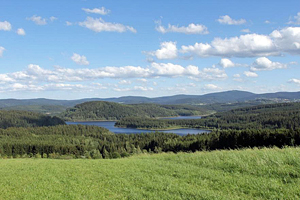Life is meant to be enjoyed, and we're here to help
The forested mountain landscape around the Kuhberg with its 48 km of hiking trails, 26 km of marked cross-country ski trails, cycle paths, open-air pools, tennis courts and horse riding centres is the perfect place to take a little time for yourself.
You won't miss out on anything, except maybe deadlines, the rush hour and the staff canteen. Discover a new side to yourself as you explore our natural, peaceful surroundings. Listen to the sounds and drink in the landscape here in the Ore Mountains and Vogtland Nature Park.
Enjoy unforgettable experiences, from the depths of the old mines up to the top of the observation tower on Kuhberg mountain (815 m above sea level), and discover the unique traditions of our landscape and people.
Get a feel for the earthy humour of our "natives", a taste for traditional Ore Mountains cuisine, and hear the old stories of our home town … put yourself right in the heart of the action.
Mountain Grasslands Trail
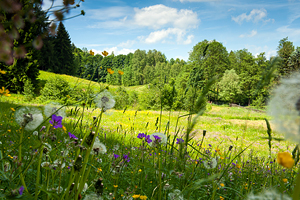
If you're a nature-lover at heart, don't miss the Grasslands Trail through the Stollmühlengrund area. The short 3.1 km circular route takes you through this shining example of an Ore Mountains valley, and is a must-see for any visitor. Mountain grasslands, meadows with Scottish Highland cattle, pools, streams, springs, woods and much more along the way mean there's something new round every corner.
One of the best views you can get of the landscape and our village comes from the former railway line up here. The beauty of the valley and all of its flora and fauna speaks for itself. Go for a wander, take it in with all of your senses. And keep a look out for the little surprises along the way. The Trail is part of the Stützengrün Mountain Grasslands Project, which has been working since reunification to bring these once fallow areas back into use.
Kuhberg and the Prinz Georg Tower
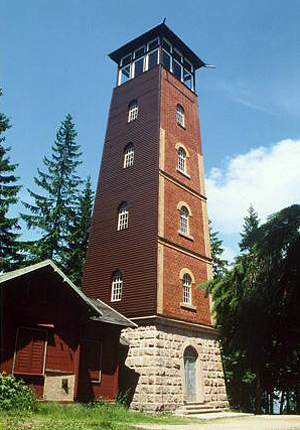
One of the most beautiful corners of our town is the 795 m high Kuhberg - "Cow Mountain". You can get to it in 30 minutes on foot, or by car along the tarmacked road. Once you arrive, we recommend taking the 99 steps up to the top of the 20 m high Prinz Georg Tower. From there, you can see right across our stunning landscapes up to the ridge of the Ore Mountains.
The nearby Berghotel is just the place to sit and reflect on what you've seen, maybe over a local speciality or two. And tired hikers can rest their aching legs in one of the comfy rooms - www.berghotel-kuhberg.de
The Heritage Railway
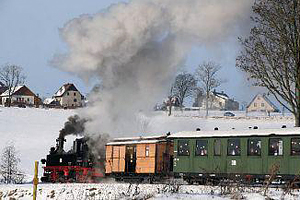
The glory of the "Bimm" trains has returned to the tracks between Schönheide and Stützengrün. On the border between the Ore Mountains and the Vogtland region, at the foot of the Kuhberg mountain, railway enthusiasts can once again enjoy a trip down part of the former Wilkau-Haßlau-Carlsfeld narrow-gauge railway. The first narrow-gauge train in Saxony left Wilkau on the 750 mm tracks in October 1881. On 14 December 1893, the line finally reached Schönheide with the opening of the Saupersdorf-Wilzschhaus section. When the extension to Carlsfeld opened in June 1897, the now 41.9 km route became the longest narrow-gauge railway in Saxony.
From 1967, the line was gradually shut down. In summer 1975, holiday services between Rothenkirchen and Schönheide Süd (Wilzschhaus) came to an end, and after the last scheduled freight service on 30 April 1977, official services were at an end. It took until 1981 to dismantle the line, which also involved tearing down Stützengrün's famous viaducts. In May 1990, however, a group of enthusiasts came together with the aim of creating a heritage line. On 05 April 1991, the "Museumsbahn Schönheide/Carlsfeld e.V." foundation was born. Today, their trains run along a 4.5 km rebuilt section of track between Schönheide and Stützengrün-Neulehn.
In 1999, a hand-operated barrier was put back in on the road crossing at Stützengrün station. The locomotives in use on the line today are the Saxon IV K99 582 and the 199051, type V10c diesel. On scheduled days, these powerful engines pull traditional passenger, luggage and freight carriages along the line for visitors.
Special trips with steam engines or diesel locomotives can be booked at other times throughout the year, and make a unique venue for a family party, a company or club trip, a group travel adventure, or any other special celebration.
The Nadlerhaus in Hundshübel
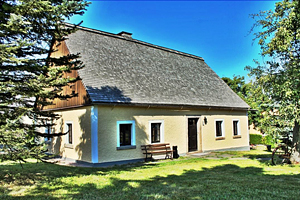
In 1536, there were 10 farmers in Hundshübel whose cows were allowed to roam and graze on the state-owned meadows. The road the farmers used to drive the animals down to reach the land can still be seen today. Its name, the "Viechzig", most likely stems from the phrase: the cattle (Vieh) come (ziehen) up to the meadow.
The Nadlerhaus on the Viechzig is one of the oldest buildings in the village. It was a day labourer's house, erected in 1750. We no longer know who built the house or why it was built. But apart from some small structural changes dating to 1872, it has remained as it was when it was first built. You can still see the stone path up to the front door, the wooden guttering, small and large water troughs and the goat stalls. When you enter the building, you can clearly see how old it is. Just as they did when it was built, large flagstones make up the floor in the corridor. The well and hand-operated pump, smoking room and a large room, used in the late 19th century for sewing, all remain.
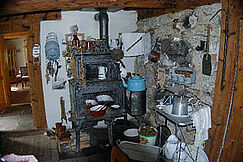
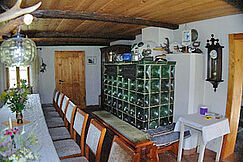
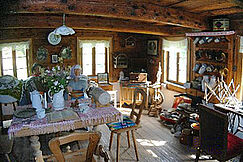
A Mrs Mädler, née Nadler, was the fourth generation of her family to own the property. Her ancestor, Engelbert Nadler, was born in Bohemia in 1862, and later moved to Saxony. In 1945/46, German exiles from the former territories in the east were brought here. After Mrs Mädler passed away in 1984, the building began to fall into disrepair. The district of Hundshübel took ownership of the property in 1988. In 1990, local authorities and residents decided to renovate the building and return it to its original state.
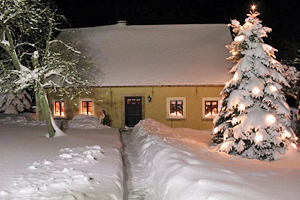
With financial support from the state of Saxony and the energy and dedication of Karl-Heinz Roßner, his ski club and local residents, a museum of local history was erected on the site. The right hand side of this building, known as the Heimatstube, explores the simple lives of our ancestors up to the present day. On the left hand side, there is a room that can hold up to 25 people, which is now used for parties and meetings.
Wolfgang Seidel, the caretaker of the building, now gives tours explaining the history of the house, which has enjoyed protected status since 1986.
If you would like to book the room for an event, please contact Ms Völker at the Stützengrün municipal offices on: 0049 37462 65411.
The Shaving Museum in Hundshübel
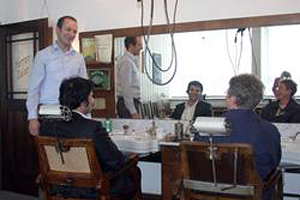
Hans-Jürgen Müller GmbH & Co. KG
Hauptstraße 18
08328 Stützengrün
Germany
Telephone: 0049 37462 652-0
Fax: 0049 37462 652-18
Email: info(at)muehle-shaving.com
Website: www.muehle-shaving.com
If you want to see something that has amazed even Albert Einstein, come and visit the "Mühle Collection" in Hundshübel. This exhibition at the Hans-Jürgen Müller GmbH & Co. KG production plant includes some 2,000 exhibits that have been collected over the past 10 years. They represent 200 years of shaving culture and history. The razors on show range from everyday disposable blades to luxury accessories. The exhibition is displayed in a historical salon dating back to the 1930s, where a wealth of unusual exhibits with fascinating stories await visitors. These include a rare case containing razor blades for every day of the week.
As they were not used every day, the steel in them had time to recover and so would give you just as clean a shave the next time around. Durability and recyclability have been the key factors for industrial design over the past 150 years. Unusual finds, including sharpening equipment, tell this story. The Be-Be-Strop, one of the many mechanical marvels on show, automatically rotated the blade when turned. A mechanism that fascinated even legendary scientist Albert Einstein. He wrote to the manufacturer in 1923: "As the proud new owner of one of your razor blade sharpening systems, I feel I must inform you of how impressed I am with the construction and design of the device." And visitors to the historic barber's shop here are sure to be just as impressed as he was. The collection does not have regular opening hours. It can be viewed on request at Jürgen Müller KG. This also applies to tour groups.
Stützengrün Christmas World
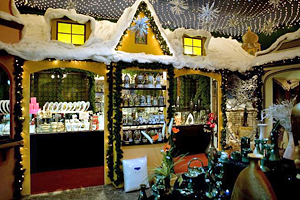
Weihnachtsland Erlebniswelt
Schönheider Straße 4
08328 Stützengrün
Germany
Telephone: 0049 37462 634645
Fax: 0049 37462 280667
Email: info(at)weihnachtsland.tv
Website: www.weihnachtslanderlebniswelt.com
Here at Stützengrün's Christmas World, you can explore this most wonderful time of year, and our local mining traditions, any time you like. See the dwarves hard at work in the mining tunnels, search for the mountain spirit, listen to Father Christmas's tales, see the elves making gifts, hear Father Christmas and his reindeer singing Christmas carols, and even see him take a bath!
Christmas World also has a shop full of 5,000 different products, including some produced right here in the Ore Mountains, numerous traditional folk art pieces and items from around the world.
Come into Santa's house and listen as he tells his stories. You'll find everything you need to decorate your Christmas tree here - original Lauscha glass ornaments and much more besides.
Then you can move on to explore the shimmering crystal room, where the shelves are bursting with the finest glassware, crystal jugs and figures, porcelain and ceramics. And a giant crystal grows from the ceiling. Stay for a while and listen to Father Christmas and his reindeer sing their carols.
Eibenstock Reservoir in Stützengrün
The Eibenstock reservoir on the edge of Stützengrün is not only Saxony's largest drinking water reservoir, but also a great place to walk and relax.
There are any number of signposted trails around its banks, complete with plenty of spots to take a break and drink in the views. If you need some extra relaxation, you’ll find two Kneipp therapy baths around Hundshübel. And there are plenty of signs along the trails to tell you more about the area's flora and fauna.




